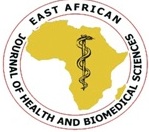Survival Status and Predictors of Mortality among Children Aged 0-59 Months Admitted with Severe Acute Malnutrition in Dilchora Referral Hospital, Eastern Ethiopia.
Abstract
Background: The mortality rate of children admitted to hospital with complicated severe acute malnourishment is as high as 35 %. In Ethiopia, this ranges from 6 % to 29 %, and its predictors vary contextually.
Objective: To assess the survival status and the predictors of mortality among 0-59 months children with severe and acute malnutrition and admitted to Dilchora Referral Hospital, Eastern Ethiopia.
Methods: A retrospective cohort study was conducted on children with Severe Acute Malnutrition (SAM) treated in Dilchora Referral Hospital. The data were collected from medical records from March 07 to 16, 2016. Six hundred seventeen children were randomly selected from all eligible records of 0-59 month’s children admitted to the center from September 2011 to August 2015. The data were collected using a pretested data extraction format and entered into EpiData software and exported to SPSS Version 20 for analysis. Survival curve was used to display the survival status among different characteristics. The Cox proportional hazard model was done to identify independent predictors of mortality. Associations were declared as statistically significant with p<0.05.
Results: It was found that 47 (7.6 %) study participants had died, most of whom had died within the first week of admission to hospital, 431 (69.9 %) had been cured, and the rest were defaulted and transferred out. The mean survival of the children with HIV/AIDS, pneumonia, diarrhea, dehydration, and those who took intravenous antibiotics and fluid were significantly lower than that of their counter parts. The significant predictors of the mortality of the SAM children were loss of appetite (AHR=2.75; 95%CI: 1.08, 6.99), malaria (AHR=12.69, 95%CI: 4.57, 35.27), lower Waist for Height % (WFH %) (AHR=0.95, 95%CI: 0.9, 0.99), and HIV sero-positivity (AHR=11.57, 95%CI: 2.34, 57.2). Also, not taking Formula-100 (F-100) (AHR=3.26; 95%CI: 1.32, 8.07) and Formula-75 (F-75) (AHR=2.56, 95%CI: 1.06, 6.15) significantly increased the risk of death.
Conclusion: The level of the mortality was high. Presence of co-morbidities, intravenous fluid and antibiotics intake and not supplemented with nutritional therapy significantly increased the risk of death. Therefore, an appropriate nutritional therapy and management of co-morbidities as per the national SAM management protocol is recommended.
Downloads
References
Projection of Ethiopia for all Regions: At Woreda level from 2014-2017. Addis Ababa, Federal
Ministry of Health: 70-90.
Bachou, H., Tumwine, J. K., Mwadime, R. K. and Tylleskär, T. 2006. Risk factors in hospital deaths in
severely malnourished children in Kampala,Uganda. BMC Pediatrics, 6:7, doi: 10.1186/1471-2431-6-7
Bhutta, Z., Das, J., Rizvi, A., Gaffey, M. F., Walker, N., and Horton, S. 2013. Evidence-based interventions
for improvement of maternal and child nutrition: what can be done and at what cost? Maternal and
Child Nutrition, 2: 1-15.
Ephrem, T. 2010. Treatment Outcome Of Children With Severe Acute Malnutrition Admitted To Therapeutic Feeding Centers In Southern Region
Of Ethiopia, . Ethiop. J. Health Dev., 24(3): 234-238. FMoH (Federal Ministry of Health). 2013. Training
Course On the management of severe Acute malnutrition. Addis Ababa, Ethiopia, 2: 10-72.
Habtemu, J., Abdulhalik, W. and Fessahaye, A. 2015. Survival status and predictors of mortality in
severely malnourished children admitted to Jimma University Specialized Hospital from 2010 to 2012,
Jimma, Ethiopia: A retrospective longitudinal study. BMC Pediatrics, 15:76 , doi: 10:1186/512884-015-
0398-4
Heikens, G. T. 2007. How Can We Improve the Care of Severely Malnourished Children in Africa? PLoS
Medicine, 4 (2).
Hobbs, B. and Bush, A. 2014. A 10 point plan for tackling acute malnutrition in under fives. Acute
malnutrition:An everydays emergency, Generation Nutrition Campaign Report, pp. 12-25.
Irena, A. H., Mwambazi, M. and Mulenga, V. 2011. Diarrhea is a Major killer of Children with Severe
Acute Malnutrition Admitted to Inpatient Set-up in Lusaka, Zambia. Nutrition Journal, 10(110): 1-6.
Kapil, U. 2009. Ready to Use Therapeutic Food (RUTF) in the management of severe acute malnutrition in
India. Indian Pediatr, 46(5): 381-382.
Kapil, U. and Sachdev, H. 2010. Management of Children with Severe Acute Malnutrition: A
National Priority. Indian Pediatrics 47: 651-654.
Keane, E. 2013. Integrating severe acute malnutrition into the management of childhood diseases at
community level in South Sudan, Malaria Consortium, pp. 1-36.
More inside the PDF



